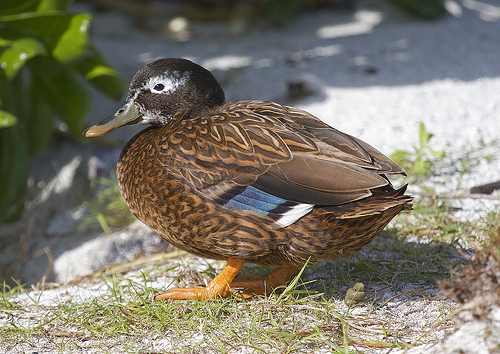
Laysan duck, or Laysan teal(Anas laysanensis)
Phylum —chordata
Class — aves
Order — anseriformes
Family — anatidae
Genus –anas
Appearance
Average weights for this duck vary with its age. An individual at age 14 can weigh 98.1 grams while an individual at age 45 can weigh 402.0 grams. Body length – 38-43 cm.
There is little difference between the plumages of males and females. Both are dull, dark brown with distinctive white eye rings and white feathering on head and neck. The main difference lies with bill coloring: the male bill is yellowish green with black spotting, while the female bill is dull orange.
Habitat
This dabbling duck is endemic to the Hawaiian Islands.
Behavior
The Laysan duck is rarely observed swimming or flying and spends about 10 percent of its time each day walking or running on the ground. During midday the ducks rest and they come out to feed on the highlands during the evening and night.
Diet
The main food staple for this species is macroinvertebrates. The Laysan duck is not a diver or swimmer and merely dips its head into the water to feed on aquatic plants, seeds and snails. They also do some filter feeding for moth larvae and pupae. A peculiar method of feeding that has been observed in this species is its tendency to run through swarms of adult brine flies with its neck extend and mouth open in order to trap the flies in its mouth.
Reproduction
Pair formation begins in fall, and nest building begins in spring. The female builds a well-concealed nest on the ground below dense vegetation. The nest is a shallow bowl lined with dead grass and down feathers. Egg-laying typically occurs from April to August. Average clutch size is approximately four bird eggs. Ducklings are precocious and feed on their own day two after hatching, but are guarded, brooded, and led to foraging sites by the hen for approximately 40 to 60 days.
Wild ducks have been known to live to the age of twelve years, and captive birds have lived to the age of eighteen.
In captivity
In summer, Laysan ducksare kept in outdoor enclosures. The minimum size of the enclosure is 3 square meters.
In winter, they should be transferred to an insulated enclosure with a temperature of at least +15 °C. It is desirable to equip the enclosure with additives in the form of branches and perches. In the winter room, you must install a pool with running or frequently replaced water.
As a winter bedding for waterfowl, you can use soft hay, which is laid out in places where birds rest.
The diet includes grain feed-corn, wheat, barley, millet, oatmeal, wheat bran, grass, meat and fish meal, chalk, small shell, gammarus. In the warm season, it is good to give various greens - cut dandelion leaves, lettuce, plantain, duckweed. Good food for ducks - wet mixture of grated carrots, bran, various cereals. During the reproductive period and during molting, they are mixed with wet foodor given separately: fish and minced meat.
Laysan ducks are friendly to other birds, so they can be kept on the same pond with other ducks.
Artificial shelters for nests are installed in the paddock. Ducks independently incubate, breed and raise ducklings.
 Russian
Russian
 English
English
























